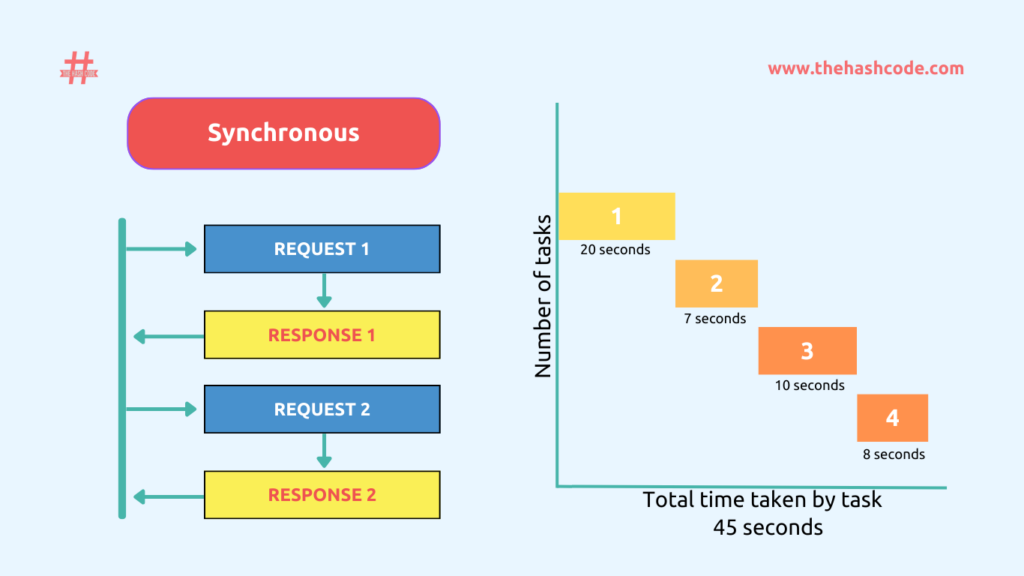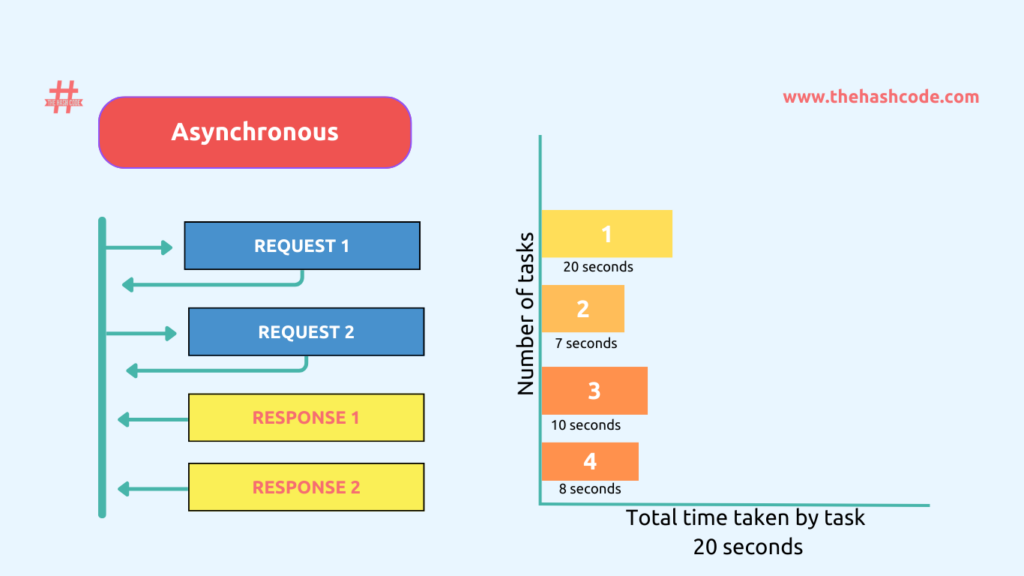Introduction:
In this blog post, we’ll dive into the concepts of synchronous and asynchronous programming in JavaScript, compare their differences, and provide practical examples to help you understand how they work in real-world scenarios.
What is Synchronous programming in JavaScript?

JavaScript’s synchronous programming executes code sequentially, processing one line at a time as the default behavior. Every task needs to be finished before the next one can begin, ensuring a sequential and orderly progression. This can lead to blocking, especially for long-running functions, and may result in a less-than-optimal user experience. While JavaScript is synchronous by default. For example, the following code snippet demonstrates synchronous behavior:
console.log('One');
console.log('Two');
console.log('Three');
// Output: 'One', 'Two', 'Three'
In this example, the code runs sequentially, with each line of code waiting for the previous one to complete before executing. This synchronous nature can lead to blocking, especially for long-running functions, and may result in a less-than-optimal user experience.
// Synchronous function to add two numbers
function addNumbers(a, b) {
console.log("Adding numbers...");
return a + b;
}
// Synchronous function to multiply two numbers
function multiplyNumbers(c, d) {
console.log("Multiplying numbers...");
return c * d;
}
// Synchronous execution
const result1 = addNumbers(2, 3);
const result2 = multiplyNumbers(result1, 4);
// Output the final result
console.log("Final result:", result2);
In this example, we have two synchronous functions, addNumbers and multiplyNumbers, each performing a specific mathematical operation. The program follows a sequential flow:
- The
addNumbersfunction is called with arguments2and3, logging “Adding numbers…” and returning the result5. - The
multiplyNumbersfunction is then called with the result of the previous operation (5) and the argument4, logging “Multiplying numbers…” and returning the final result20. - Finally, the program outputs “Final result: 20”.
Synchronous programming’s key feature: each function call blocks execution, ensuring a predictable, sequential flow of operations until completion. Simplicity is advantageous, but synchronous programming may cause performance issues with time-consuming tasks, halting the entire program until completion.
When to use Synchronous programming?
Here are some key points on when to use synchronous programming in JavaScript:
- Simplicity: When simplicity is the goal over efficiency, synchronous programming is a suitable choice for implementation.
- Front-end web applications: Synchronous programming is ideal for front-end web apps, mathematical computations, video rendering, or basic CPU functions in development.
- Single-task operations: When the application doesn’t need to handle multiple tasks at once, synchronous programming is suitable for execution.
- Basic operations: Basic operations not needing complex logic or lengthy functions can utilize synchronous programming effectively.
- Compatibility: Compatibility concerns with older systems may prompt the use of synchronous programming in certain scenarios for web development.
In summary, developers opt for synchronous programming in JavaScript for simplicity rather than efficiency, especially in front-end web applications, single-task operations, basic executions, or concerns about compatibility with older browsers or systems.
What is Asynchronous programming in JavaScript?

In asynchronous programming JavaScript allows a program to work on multiple tasks simultaneously, instead of waiting for each task to be completed. Efficiently handle time-consuming tasks such as network queries or file operations by embracing asynchronous programming, preventing inefficiencies from waiting for completion.
Asynchronous programming techniques enable the seamless loading of data in the background while ensuring a responsive and engaging user experience. JavaScript achieves asynchronous programming through techniques like callbacks, promises, and async/await. Grasping asynchronous programming is crucial for building high-performance web apps, whether you’re a seasoned developer or a JavaScript beginner.
Here’s an example of asynchronous programming in JavaScript using Promises:
// Asynchronous function to simulate fetching data
function fetchData() {
console.log("Fetching data...");
return new Promise((resolve, reject) => {
setTimeout(() => {
const data = { name: "John", age: 25 };
resolve(data); // Resolve the Promise with the fetched data
}, 2000);
});
}
// Asynchronous function to process the fetched data
function processData(data) {
console.log("Processing data...");
console.log("Name:", data.name);
console.log("Age:", data.age);
}
// Asynchronous execution with Promises
fetchData()
.then(processData) // Chain a Promise to process the fetched data
.catch((error) => console.error("Error:", error));
console.log("Program continues...");
In this example:
- The
fetchDatafunction simulates fetching data asynchronously using aPromise. It logs a message and resolves thePromisewith some sample data after a 2-second delay. - The
processDatafunction logs a message and outputs specific details from the fetched data. - The asynchronous execution is achieved by chaining the
thenmethod to thefetchDatacall. This ensures that once the data is successfully fetched, theprocessDatafunction is invoked to handle the data. - The
catchmethod is used to handle any errors that may occur during the asynchronous operations.
The program doesn’t halt for data fetching, allowing concurrent tasks to proceed. Asynchronous programming is particularly beneficial when dealing with operations that take time, such as fetching data from an external server, to avoid blocking the entire program.
When to use Asynchronous programming in JavaScript?
Here are some key points on when to use asynchronous programming in JavaScript:
- Time-consuming processes: Asynchronous programming is useful when dealing with time-consuming processes like network queries or file operations, where waiting for each task to be completed before moving on would be inefficient.
- Responsive user experience: Asynchronous programming enables the seamless loading of data in the background while ensuring a responsive and engaging user experience.
- Handling interactions and events: Asynchronous programming is essential for handling interactions and events in contemporary web applications, enabling programmers to react quickly to user events without causing the user interface to halt.
- Resource efficiency: Asynchronous programming increases resource efficiency and speeds up execution by carrying out activities in an asynchronous manner, allowing the computer to run other pieces of code while waiting for the results.
- Compatibility: Asynchronous programming is useful when compatibility with older browsers or systems is a concern.
In summary, asynchronous programming in JavaScript is useful when dealing with time-consuming processes, ensuring a responsive user experience, handling interactions and events, increasing resource efficiency, and when compatibility with older browsers or systems is a concern.
Method of handling Asynchronous programming
There are several methods of handling asynchronous programming in JavaScript, including:
1. Callbacks:
Functions passed as arguments in JavaScript, callbacks execute upon completion of the function’s task, facilitating asynchronous operations. Callbacks are a common way to handle asynchronous programming in JavaScript.
An example of using callbacks to handle asynchronous programming in JavaScript is as follows:
// Asynchronous function that simulates data retrieval from a server
function fetchData(callback) {
// Simulate a server delay using setTimeout
setTimeout(() => {
const data = 'This is the data';
callback(data); // Execute the callback with the retrieved data
}, 2000); // Simulate a 2-second delay
}
// Callback function to handle the retrieved data
function displayData(data) {
console.log('Retrieved data: ' + data);
}
// Call the asynchronous function with the callback
fetchData(displayData);
In this example, the fetchData function simulates data retrieval from a server with a 2-second delay using setTimeout. It takes a callback function as an argument and executes it with the retrieved data after the delay. The displayData function is the callback that handles the retrieved data. When fetchData is called with the displayData callback, it logs the retrieved data after the 2-second delay. This demonstrates the use of a callback to handle the asynchronous operation of data retrieval.
2. Promises:
In JavaScript, Promises are objects that represent the eventual completion or failure of an asynchronous operation and allow for more readable and maintainable code. Promises manage asynchronous operations, enabling efficient handling of time-consuming tasks without blocking the main thread.
An example of using promises to handle asynchronous programming in JavaScript is as follows:
// Asynchronous function that returns a promise to simulate data retrieval from a server
function fetchData() {
return new Promise((resolve, reject) => {
// Simulate a server delay using setTimeout
setTimeout(() => {
const data = 'This is the data';
resolve(data); // Resolve the promise with the retrieved data
}, 2000); // Simulate a 2-second delay
});
}
// Using the promise to handle the retrieved data
fetchData()
.then(data => {
console.log('Retrieved data: ' + data);
})
.catch(error => {
console.error('Error: ' + error);
});
In this example, the fetchData function returns a promise to simulate data retrieval from a server with a 2-second delay using setTimeout. The then method is used to handle the resolved data, and the catch method is used to handle any errors that occur during the asynchronous operation. This demonstrates the use of promises to handle asynchronous operations in a more organized and readable manner.
3. Async/await:
In JavaScript Async/await is a newer technique that allows developers to write asynchronous code that looks and behaves like synchronous code, making it easier to read and maintain. Async/await builds on promises, managing operations that are asynchronous and time-consuming, ensuring efficient handling of delays.
Here’s an example of using the async/await method to handle asynchronous programming in JavaScript:
// Asynchronous function that returns a promise to simulate data retrieval from a server
function fetchData() {
return new Promise((resolve, reject) => {
// Simulate a server delay using setTimeout
setTimeout(() => {
const data = 'This is the data';
resolve(data); // Resolve the promise with the retrieved data
}, 2000); // Simulate a 2-second delay
});
}
// Using the async/await to handle the retrieved data
async function displayData() {
try {
const data = await fetchData();
console.log('Retrieved data: ' + data);
} catch (error) {
console.error('Error: ' + error);
}
}
// Call the async function to display the retrieved data
displayData();
In this example, the fetchData function returns a promise to simulate data retrieval from a server with a 2-second delay using setTimeout. The async function displayData uses the await keyword to handle the resolved data and the try...catch block to handle any errors that occur during the asynchronous operation. This demonstrates the use of async/await to handle asynchronous operations in a more readable and maintainable manner.
4. Event listeners:
Event listeners handle asynchronous events like user input, network requests, and other asynchronous occurrences effectively.
An example of using event listeners to handle asynchronous programming in JavaScript is as follows:
// Asynchronous function that simulates data retrieval from a server
function fetchData() {
const event = new Event('dataRetrieved');
setTimeout(() => {
const data = 'This is the data';
document.dispatchEvent(event); // Dispatch the event with the retrieved data
}, 2000); // Simulate a 2-second delay
}
// Event listener to handle the retrieved data
document.addEventListener('dataRetrieved', (event) => {
console.log('Retrieved data: ' + event.data);
});
// Call the asynchronous function to fetch the data
fetchData();
In this example, the fetchData function simulates data retrieval from a server with a 2-second delay using setTimeout. It creates a custom event and dispatches it with the retrieved data. The document.addEventListener method is used to handle the event and log the retrieved data. This demonstrates the use of event listeners to handle asynchronous operations in a more organized and readable manner.
There are several methods of handling asynchronous programming in JavaScript, including callbacks, promises, async/await, and event listeners. Each method has its advantages and disadvantages, and the choice of method depends on the specific use case and the developer’s preference.
Advantage and Disadvantages of synchronous and Asynchronous programming
Synchronous programming:
Here is the advantages and disadvantages of synchronous programming:
| Advantages | Disadvantages |
|---|---|
| Efficient execution of tasks | Difficulty in achieving concurrency and communication between threads |
| Reliable, as errors are detected and handled before causing significant damage | Can be difficult to scale up |
| Easier to learn and use, with fewer potential headaches | Blocking calls, as each operation must be completed before the next one can start |
| Linear and sequential nature, making the code simpler to visualize and understand | In synchronous execution, each operation must be completed before the next one can start, preventing other work from happening while waiting for I/O to complete |
| Works well for simple CPU tasks and programs with minimal I/O waits | Can be slow and resource-intensive, especially for complex tasks |
Synchronous programming is typically more efficient but can be less responsive to user input. It is easier to learn and use, with fewer potential headaches. However, it has some drawbacks, such as blocking calls and difficulty in scaling up.
Asynchronous programming:
Here is a table summarizing the advantages and disadvantages of asynchronous programming:
| Advantages | Disadvantages |
|---|---|
| Improved performance and scalability due to non-blocking nature | Increased code complexity and potential for nested callbacks |
| More responsive user interfaces | Potential for server overload with too many asynchronous requests |
| Allows for parallel execution of tasks, maximizing resource utilization | Requires more experience and discipline to keep code organized |
| Prevents UI thread from being blocked, keeping the UI responsive | Can be more difficult to debug and target errors |
Asynchronous programming enhances performance, scalability, and responsiveness, ideal for independent tasks running concurrently in the background. However, it can lead to increased code complexity and potential for server overload with excessive asynchronous requests.
Conclusion:
Understanding synchronous and asynchronous programming in JavaScript is essential for creating efficient and functional web applications. Synchronous programming maintains predictability and order, while asynchronous programming handles time-consuming tasks without interruptions.
Developers often choose between synchronous and asynchronous methods based on the specific requirements of their applications. Familiarity with both models allows for more robust and efficient JavaScript code, improving the overall user experience. Explore synchronous and asynchronous programming in JavaScript, experiment in real-world scenarios, control their power, and create dynamic web applications—it’s a job. Learn more about node.js architecture.
FAQ:
1. What is synchronous and asynchronous JavaScript?
Synchronous JavaScript executes code sequentially, with each operation waiting for the previous one to complete before starting. Asynchronous JavaScript allows operations to execute independently of the main program flow, enabling non-blocking operations like fetching data from a server without halting the execution of subsequent code.
2. What is asynchronous programming in JavaScript?
Asynchronous programming in JavaScript allows a program to perform multiple tasks simultaneously without waiting for one task to complete before starting another. This improves performance and responsiveness, especially for tasks that may take a long time to complete, such as network requests or file operations.
3. What are synchronous and asynchronous promises in JavaScript?
Synchronous promises in JavaScript execute code immediately and block further execution until completed, while asynchronous promises allow code to execute in the background, not blocking the main thread, and resolve or reject at a later time.
4. What is the difference between asynchronous and synchronous?
Synchronous means happening at the same time, while asynchronous means not happening at the same time. In communication, synchronous involves real-time interaction, like face-to-face or video calls, while asynchronous involves exchanging messages at different times, like email or text messages.


Leave a Comment